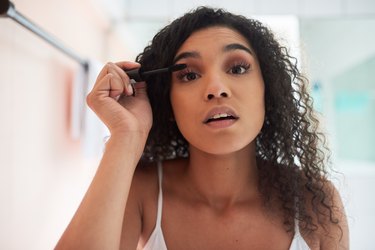
You're not crying or chopping onions. So why are your eyes so teary?
Watery eyes can happen when your peepers get irritated from things like smoky air or swimming in a pool.
Video of the Day
Video of the Day
But they can also be a clue to an underlying eye condition, says Barrett Eubanks, MD, an ophthalmologist in Murrieta, California. Especially if the tearing isn't easing up or it's happening alongside other symptoms.
If you're not sure what's causing your watering, read on. Here are seven common causes and what you can do to feel better.
1. There's Something Irritating Your Eye
Anytime your eyes are irritated, your tear glands start producing more tears to try to rinse away the offending substance, Dr. Eubanks says.
Environmental irritants like smoke, smog, pool chlorine and even dry or windy weather are common culprits that can also leave your eyes feeling gritty or grainy.
Foreign objects like an eyelash or dirt particle can have the same effect, but in that case, you'll likely only have one eye that won't stop watering.
Fix It
Help your tear ducts do their job by gently rinsing your eye or eyes with warm water or a saline solution to help clear out the irritant.
"Avoid trying to rub your eyes, since this can make the irritation worse," Dr. Eubanks says.
If rinsing doesn't help, seek medical help. Continuing to try to remove the object yourself could damage your eye, according to the Mayo Clinic.
2. You Have Dry Eye
Dry eyes, which happen when your eyes don't make enough water and oils to keep your eyes lubricated, can actually make them teary.
"When the eyes dry out, the tear gland is stimulated to produce an excess amount of tears," Dr. Eubanks says.
You might also notice an uptick in sensitivity or experience redness, stinging or burning.
Dry eyes can be caused in the short term by things like dehydration or too much screen time, or they may be a complication of another condition, such as diabetes.
Fix It
A few drops of artificial tears can deliver quick relief. We like Refresh Digital PF Lubricant Eye Drops ($13.12, Amazon).
But to keep the problem from coming back, you may need to make lifestyle adjustments like taking more frequent screen time breaks or running a humidifier to add moisture to the air, the Mayo Clinic notes.
See your eye doctor if lifestyle measures aren't helping. Sometimes dry eye is caused by an underlying condition that requires prescription eye drops or other medications to increase your tear production.
3. It's Allergies
Watery eyes (along with itching, redness or crusting) that seem to strike when you wake up or after spending time outside could be caused by an allergy to irritants like pollen, ragweed or mold, according to Johns Hopkins Medicine.
Congestion, itchy skin and symptoms that seem to ease up when you're away from the irritant are other clues you're dealing with an allergy.
Fix It
Applying a cool compress can ease irritation and turn down the waterworks, Johns Hopkins Medicine says.
You'll need to stick with a solid allergy-management plan to keep the problem from coming back, though. That starts with identifying and avoiding (or at least limiting your exposure to) the thing(s) you're allergic to.
Let your doctor know about your symptoms too: They might recommend taking an allergy medication or anti-allergy eyedrops.
4. You Have Pink Eye
Pink eye, or what doctors call conjunctivitis, is a type of inflammation sometimes caused by a viral or bacterial infection that can make your eyes watery as well as painful, itchy, red, sensitive and mucus-filled.
When it's caused by an infection,it usually starts in one eye but can easily transfer to the other by rubbing your eyes.
Fix It
Start by seeing your doctor if you think you have pink eye. They can tell you if the inflammation is caused by a viral or bacterial infection or something else, and determine the best way to treat it.
Viral pink eye will usually clear up on its own in a week or two, while antibiotic eye drops are usually needed for bacterial pink eye.
In both cases, applying a cool compress to your eye can deliver soothing relief, which may help reduce watering, per the American Academy of Ophthalmology (AAO).
5. It's a Blocked Tear Duct
A blocked tear duct, which typically affects just one eye, makes it harder for your eye to drain normally. The result is excessive tearing along with redness, swelling, and crusting, along with a greater chance for infections, per the Mayo Clinic.
Infants tend to be affected the most, but adults can also develop blocked tear ducts from eye injuries, chronic eye inflammation or autoimmune disorders, Dr. Eubanks says.
Fix It
Surgery may be needed to fix a blocked tear duct, so see your doctor to discuss your options.
In the meantime, a wet compress can help reduce irritation and keep your eyes more comfortable, says Dr. Eubanks.
6. You've Got a Stye
Styes are small, red, pimple-like bumps that form when an oil gland around the eyelid becomes blocked and infected. This causes your eye to produce more tears (as well as mucus) to try to fight off the infection.
You might also experience pain, sensitivity to light and crusting, says the AAO.
Fix It
Start with a tried-and-true stye remedy: Apply a warm compress to the affected area for 10 to 15 minutes, three to five times a day, the AAO recommends. (But don't try to squeeze or pop it. That could cause the infection to spread.)
This might be enough to help the stye heal within a few weeks. If it's not getting better, though, see your doctor. The stye may be infected and need antibiotics.
7. You Have a Corneal Abrasion
Corneal abrasions happen when an object (like metal, debris or even your fingernails) scratch the surface of your eye. They can cause pain and irritation, along with watering, redness, blurry vision and sensitivity to light, according to the Cleveland Clinic.
Having dry eyes, wearing contact lenses or repeatedly rubbing your eyes can all up your risk.
Fix It
See your doctor if you think you have a corneal abrasion. They can examine the scratch to see how severe it is, prescribe antibiotic eye drops or ointment to help you avoid an infection and apply a bandage contact lens to help the abrasion heal, the Cleveland Clinic says.
They may also prescribe numbing eye drops to help manage the pain.
When to See a Doctor About Watery Eyes
A few extra tears aren't always a big deal. But you should see your eye doctor if your eyes are persistently watery or irritated, because those could be signs of problems like dry eye, undermanaged allergies, an eye infection or an eye injury, Dr. Eubanks says.
Together, you and your doctor can pinpoint the underlying problem and get the tearing under control.
FAQ
1. Do Watery Eyes Mean You're Sick?
Red, watery eyes can sometimes come with a cold in kids, according to Seattle Children's. Other cold symptoms often include a runny nose, cough, sore throat and hoarse voice. Fevers are also a common cold symptom in children.
2. Can High Blood Sugar Cause Watery Eyes?
Yes. Over time, high blood sugar can damage the nerves in your eyes, which can both decrease tear production and lead to poor-quality tears (i.e. tears that don't stick to the eye very well), according to the American Diabetes Association. Fewer and poorer-quality tears can both lead to watery eyes.
- Johns Hopkins Medicine: "Allergic Conjunctivitis"
- American Academy of Ophthalmology: "Conjunctivitis: What Is Pink Eye?"
- Mayo Clinic: "Blocked Tear Duct"
- American Academy of Ophthalmology: "What Is the Difference Between a Stye and a Chalazion? Causes, Symptoms, Treatment"
- Cleveland Clinic: "Corneal Abrasion"
- Mayo Clinic: "Foreign object in the eye: First aid"
- Mayo Clinic: "Dry eyes"
- American Diabetes Association: "Eye Health: Dry Eye With Diabetes"
Was this article helpful?
150 Characters Max
0/150
Thank you for sharing!
Thank you for your feedback!
Is this an emergency? If you are experiencing serious medical symptoms, please see the National Library of Medicine’s list of signs you need emergency medical attention or call 911.

